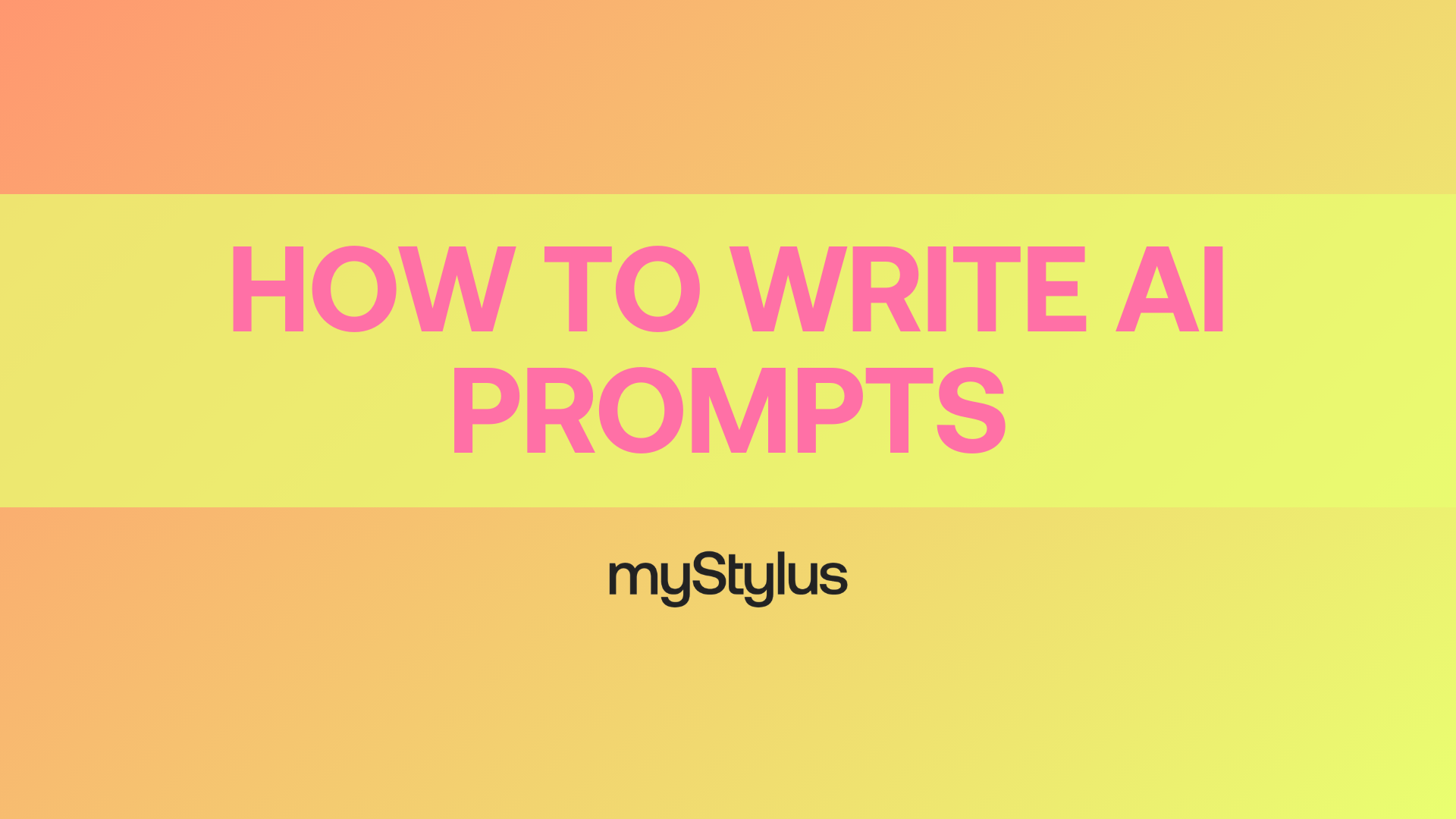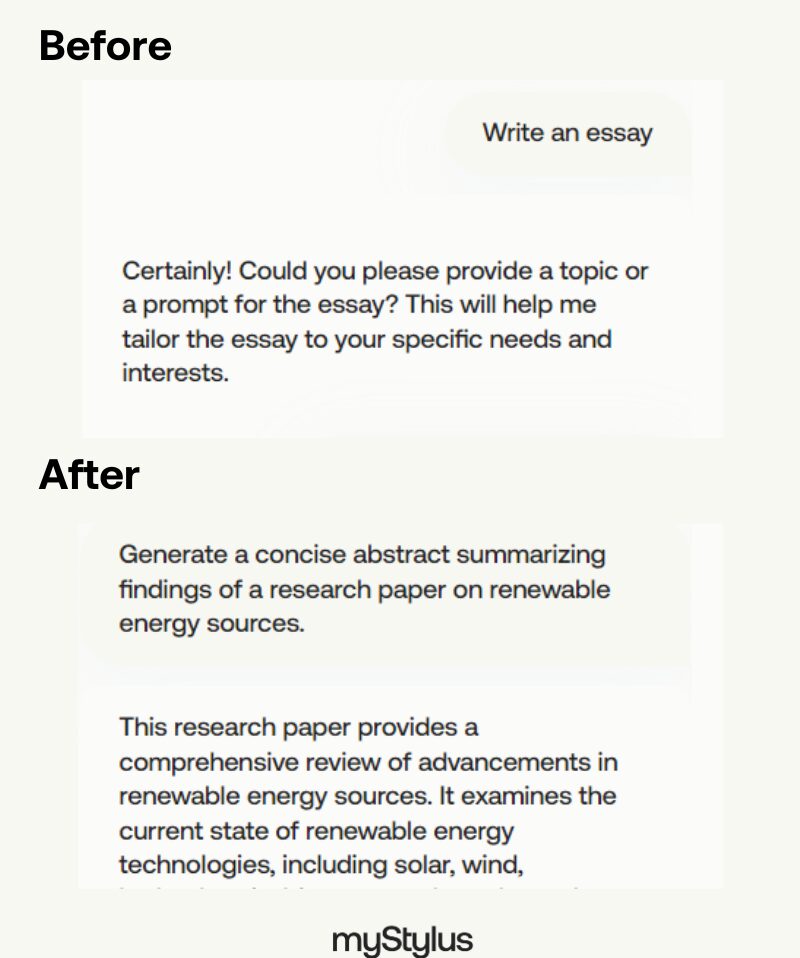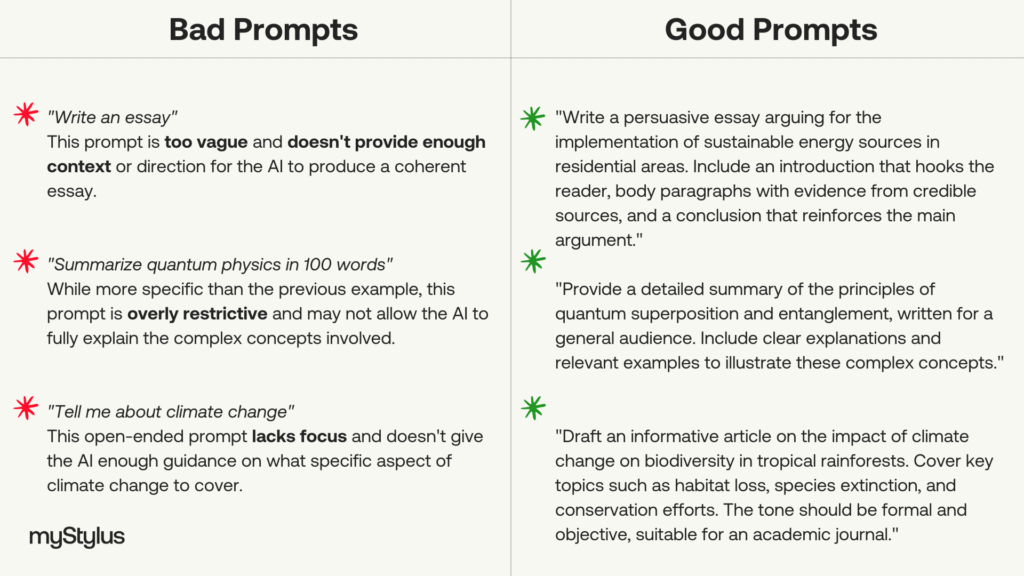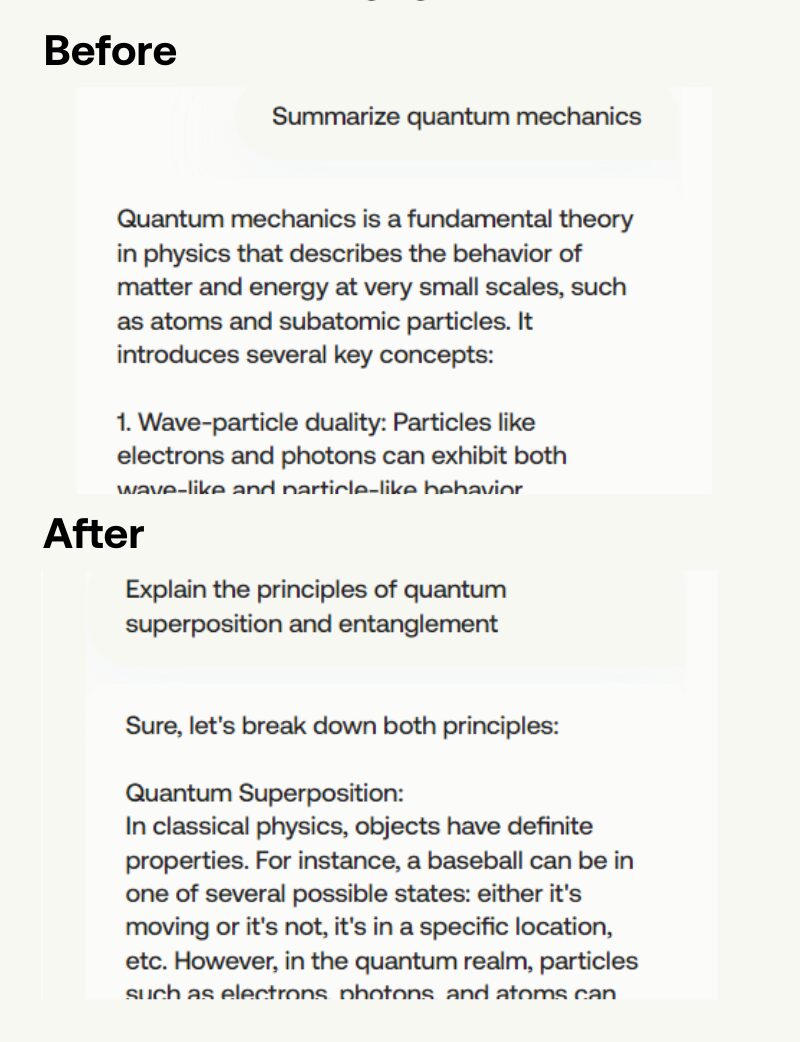How to Write Prompts
- January 1, 2025
- 13 mins read

While AI is capable of incredible feats, it requires assistance to achieve them. Artificial intelligence algorithms need a solid foundation to function properly. That’s the purpose of AI prompting.
How to write good AI prompts is the natural question that follows. Is there a magic formula that, when you use your AI writer, always produces the results you desire? No, there isn’t. Nevertheless, you have the option to customize your AI chat agent’s cues so that each interaction is unique.
To help you get the most out of your AI generation, we’ll examine the best practices for organizing your prompts and how to refine them via iteration.
What Are AI Writing Prompts Exactly?
When you want AI to produce a particular piece of content, you give it an AI writing prompt. These prompts are a set of structured instructions that guide the AI engine to create written content tailored to a particular theme, style, or purpose.
Writing AI prompts is an art form that demands both precision and creativity. A good prompt can streamline your writing process and make it much easier to get work done quickly. However, writing prompts are not all created equal. Some are better than others in getting what you want from your chosen AI engine. It all starts with how you structure your AI prompt.
Structuring AI Writing Prompts Effectively
Most people who use AI generators know that AI prompt writing is an inexact science. However, a well-structured prompt can give us something to build on for the best first-iteration results.
The best AI writing prompts have several elements that help the AI understand what you’re going for. Among these are:
| Mood | Events | Tone |
| Content | Subject | Actions |
An AI prompt does not need to contain all or any of these, but by giving it something like this to work from, you will get a far better result than asking the engine for something vague also it can save your time when you try to bypass ai detectors.
Becoming a Prompt-Master: How To Write Effective AI Prompts
Writing effective AI prompts doesn’t have to be an uphill battle. We already have a general idea of what makes a decent structure for an AI prompt. However, we can refine this initial prompt further using these AI prompt tips.
Set The Goal
What do you want your AI to give you as a result? It sounds like a simple request, but most people aren’t sure what they want the output to look like. Knowing what you want as a result is one crucial element of writing good prompts for AI. By clarifying the intended goal, you can tailor the prompt to elicit the specific type of response needed.
Ultimately, the essence of how to write good prompts for AI lies in articulating your vision with precision and openness, setting the stage for a productive and creative partnership. For example, if you want to offer engaging storytelling, the prompt might include vivid imagery and character descriptions. A well-rounded description is more likely to produce the desired result than something vague.
On the other hand, if the aim is to generate informative articles, the prompt could focus on clear and concise explanations of a topic. AI can excel at simplifying a complex topic, but only if it’s given background information about the intended audience.
Provide Detailed Instructions
A great tip on how to prompt AI relies on you seeing AI as a chat partner, not as a tool to give you your final result. To this end, AI can’t read your mind (not yet, at least). Clear, straightforward instructions yield optimal results.
For academic writing and editing, precise prompts might include: “Generate a concise abstract summarizing findings of a research paper on renewable energy sources.” Here, we see that the prompter asked for a summary, giving the AI a basic starting point (the research paper) and an exact topic (renewable energy sources).
After we’ve asked MyStylus for a too vague response, it immediately asked us to specify it, as it can’t read our minds. You can eliminate this stage by providing a detailed prompt of what exactly you want from AI.

Specificity aids AI in understanding the task’s scope, style requirements, and expected outcome, enhancing the likelihood of generating accurate and relevant content. The more specific your prompt is, the more likely you can use the initial draft as a starting point.
Check Grammar and Spelling
AI chat tools like Claude and ChatGPT rely on what you tell them to write something that makes sense. As the prompter, the onus is on you to give it a sound input. Even great AI prompts require you to reread them to ensure you didn’t make any spelling or grammatical errors.
For instance, misspelled words might trigger incorrect associations or produce nonsensical results. Similarly, poor grammar can distort the prompt’s intended meaning, resulting in off-topic or irrelevant responses. All it takes is a single misplaced word or phrase to give you unusable results.
Provide Context
Context is everything in AI prompting. AI needs to know the purpose of your text and the intended audience to give you something you can use. For tasks like speech editing, providing relevant context aids AI in generating specific results aligned with the intended audience or purpose.
For example, a prompt could specify: “Revise a speech for a corporate conference on sustainability, targeting a diverse audience of industry professionals.” Here, we see that the audience (industry professionals) is highlighted, a goal is given (revise the speech), and usage is also included (for a corporate conference on sustainability).
Remember, in AI prompt help, specificity and context are your allies in transforming a simple draft into a polished piece of communication. Contextual details such as audience demographics, tone, and purpose enable AI to understand the nuances of the task better, resulting in more relevant and effective output. Give your AI generator as much information as possible, and you’ll have a perfect first draft to work from.

Assign an Identity or Profession to the AI
One of the advanced AI prompting hacks that professionals use is to ask the AI to pretend to be a professional or to adapt an identity. Advising the AI to adopt an identity gives access to expert information that the standard user wouldn’t get.
For instance, a teacher requesting a student’s perspective on academic work might yield insights tailored to educational needs. A prompt could instruct: “Provide feedback on this essay as if you were a high school student, focusing on clarity and relevance to the assigned topic.”
Role-playing with the AI by letting it adopt an identity or the persona of a professional within an industry can offer profound insights. It also gives the initial result a more grounded feeling and can delve deeper into a topic than a non-specialist can.
Explore What MyStylus Can Offer
A tool like MyStylus has a lot of depth. Trained on a vast volume of text, the LLM offers deep insight into many topics once users know how to use prompts effectively. This AI prompt guide will help with using the tool, but even so, it offers a lot under the hood.
Experimenting with MyStylus and reading some of its documentation will open you up to doing more with the tool. Since it’s based on a well-developed methodology and is trained on professionally written articles, it’s much more specific than general AI tools.
Whether outlining, refining writing techniques, or discovering advanced AI tools, referring to MyStylus’s capabilities ensures users make the most of its resources and maximize their productivity and creativity.
Experiment With Your Prompts
Your prompts are unique, and while there is a standard structure for prompts, there is no hard-and-fast rule about how they should be written. When trying to understand how to write better AI prompts, you should remember that they are designed to give you flexibility. Prompts are like a modern equivalent to a programming language, except you can naturally speak to the processing engine.
For instance, if the AI’s response lacks depth when asked to summarize a complex topic, try breaking the prompt into simpler, more specific questions. Instead of “Summarize quantum mechanics,” try “Explain the principles of quantum superposition and entanglement.” Add details you want to see in your initial result to give the engine more information.
You can see, that MyStylus AI adapted the result exactly to the prompt, explaining the terms we asked him to:

Occasionally, your initial prompts might give you something totally unlike what you wanted. In such a case, revamping the entire prompt might be easier than refining what you initially described. Drawing inspiration from different sources or rephrasing prompts from alternative viewpoints can spark fresh ideas and stimulate more relevant outputs.
Remember, AI’s versatility allows for endless experimentation with prompts, offering ample opportunities to refine and tailor inputs for optimal results. While some elements would help to build great initial results, don’t be afraid to change things around or use a different initial approach.
A Few Additional Tips on How to Write Effective Prompts for AI
These tips will help you develop better, more efficient AI prompts:
- Keep prompts concise: Long prompts may confuse the AI or dilute the intended message. Aim for clarity and brevity to ensure the AI understands the task accurately.
- Request cited resources: If accuracy and credibility are what your draft needs, ask the AI to provide sources or citations to support its generated content.
- Ask open-ended questions: Encourage creativity and exploration by framing prompts as open-ended inquiries rather than rigid commands. This allows the AI to generate more diverse and imaginative responses.
- Repeat the original request: Prompt the AI to reiterate the task or question before generating a response. This ensures clarity and helps the AI stay focused on the intended prompt. When doing prompt writing, AI will take what you give it and create a piece of content built on top of what you ask for.
- Break down complex tasks: For intricate or multi-faceted prompts, break them down into smaller, more manageable sub-tasks to prevent confusion and ensure thorough responses.
- Use keywords strategically: Incorporate relevant keywords or phrases in the prompt to steer the AI’s focus toward specific topics, themes, or content elements.
- Incorporate feedback loops: After receiving the AI’s initial output, provide feedback or guidance based on the results to refine subsequent prompts and improve future interactions.
- Experiment and iterate: Don’t be afraid to experiment with different prompt structures, wording variations, or approaches to discover what yields the best results. Iterative refinement is critical to optimizing AI interactions over time.
AI Prompt Templates That You Can Use
These prompts aren’t meant to be a strict rule but rather a generalization that you can use as a starting point:
Writing Prompts
[Type of writing task] + [Specific topic or subject] + [Additional instructions or requirements]
- Argumentative Essay: Argue for or against the effectiveness of social media in fostering meaningful connections.
- Research Paper: Investigate the impact of climate change on biodiversity in tropical rainforests.
- Creative Writing: Craft a short story set in a post-apocalyptic world where humans coexist with sentient robots.
Drafting Prompts
[Type of document] + [Main purpose or goal] + [Key points or sections to include]
- Presentation Outline: Outline a PowerPoint presentation on the benefits of renewable energy sources for a general audience.
- Thesis Proposal: Draft a proposal outlining the research objectives and methodology for a study on the effects of technology on childhood development.
- Lesson Plan: Develop a lesson plan for teaching fractions to elementary school students using interactive activities and visual aids.
Editing Prompts
[Type of document] + [Specific areas for improvement] + [Style or formatting guidelines]
- Manuscript Editing: Edit a scientific manuscript for clarity, coherence, and adherence to APA citation style.
- Resume Review: Provide feedback on a resume, focusing on optimizing content, formatting, and highlighting relevant skills and experiences.
- Blog Post Editing: Edit a blog post for an online publication, ensuring engaging language, SEO optimization, and alignment with the publication’s tone and style.
Consider using this AI prompt template to shortcut your work.
Reviewing Prompts
[Type of document] + [Key criteria or aspects to evaluate] + [Desired outcome or recommendations]
- Peer Review of Research Paper: Review a peer’s research paper, focusing on the strength of arguments, the validity of sources, and suggestions for improvement.
- Book Review: Write a critique of a recently published novel, evaluating its plot development, characterizations, and thematic elements.
- Journal Article Review: Evaluate a scholarly journal article in the field of psychology, assessing its methodology, findings, and implications for future research.
Common AI Prompting Mistakes
Even with the best AI tools at your disposal, writing effective prompts is not always straightforward. Small errors in how you phrase a request can lead to vague, inaccurate, or even nonsensical responses. Recognizing and avoiding these mistakes can dramatically improve your AI-generated results.
1. Being Too Vague
One of the most frequent mistakes is providing an AI with an unclear or overly broad prompt. AI needs guidance to generate meaningful results, and if your instructions are too general, the response may be generic or irrelevant.
Example of a vague prompt:
“Write an article about technology.”
Better prompt:
“Write a 1,000-word article discussing the impact of artificial intelligence on cybersecurity, including key challenges and emerging solutions.”
Adding specifics about the topic, length, and focus areas ensures that the AI delivers more precise and useful content.
2. Overloading the Prompt with Too Many Instructions
While details are crucial, stuffing too many instructions into a single prompt can overwhelm the AI, leading to convoluted or incomplete responses.
Example of an overloaded prompt:
“Write a formal yet engaging blog post about electric vehicles, including their history, current technology, environmental impact, government policies, future predictions, and comparisons to gas-powered cars in terms of efficiency, cost, and public perception.”
Better prompt:
“Write an engaging blog post about the environmental impact of electric vehicles. Discuss their benefits compared to gas-powered cars and mention recent technological advancements.”
Breaking down a complex request into smaller, separate prompts can help produce higher-quality content.
3. Forgetting to Specify Tone and Style
AI-generated content varies greatly depending on tone and style, which many users forget to specify. Without this guidance, the response may not fit your intended audience.
Example of an unspecified tone:
“Explain quantum mechanics.”
Better prompt:
“Explain quantum mechanics in a simple and engaging way for high school students, using analogies and examples.”
Adding audience and tone specifications ensures clarity and readability in the output.
4. Not Providing Enough Context
AI models don’t have prior knowledge of your exact needs unless you provide context. A lack of background information can result in responses that are too general or miss key details.
Example of insufficient context:
“Summarize this text.”
Better prompt:
“Summarize this 500-word article about remote work trends in 2024, focusing on the benefits for employees and challenges for employers.”
Context allows the AI to tailor its response more effectively to your needs.
5. Ignoring Grammar and Clarity
Typos, ambiguous wording, and poor grammar can confuse the AI, leading to unexpected or incorrect results.
Example of unclear prompt:
“Make a report AI chatbot how work.”
Better prompt:
“Write a report explaining how AI chatbots function, including an overview of their key components and how they process user input.”
Taking a moment to review your prompt for errors can save time and prevent confusion.
6. Expecting AI to Read Your Mind
AI does not infer meaning beyond what is provided. If your prompt assumes prior knowledge or lacks clear direction, the AI might generate something far from your intended result.
Example of an unclear prompt:
“Give me a summary of this document.”
Better prompt:
“Summarize this legal contract, highlighting the key obligations of both parties and any termination clauses.”
Explicit instructions help AI understand what aspects to prioritize.
7. Failing to Iterate and Refine
A common misconception is that the first AI-generated response will be perfect. Effective AI prompting is an iterative process—refining and rewording prompts can significantly improve results.
Example of a single attempt prompt:
“Write a press release about our new software launch.”
Better approach:
-
“Draft a press release announcing the launch of our new, reliable project management software, emphasizing its time-saving features for remote teams. Highlight how it enhances collaboration, streamlines workflows, and ensures projects stay on track with minimal effort.”
-
“Refine the press release to include a quote from our CEO and a call to action for potential customers.”
-
“Make the language more engaging and concise.”
By iterating on the prompt, you ensure that the final output aligns with your expectations.
8. Using Leading or Biased Prompts
When asking AI to generate content, framing questions in a biased or leading way can result in skewed information.
Example of a biased prompt:
“Explain why electric vehicles are the worst choice for consumers.”
Better prompt:
“Discuss the pros and cons of electric vehicles for consumers, including cost, range, and environmental impact.”
Neutral phrasing allows for a more balanced and informative response.
9. Expecting AI to Be Perfect Without Editing
AI-generated content often requires human revision to refine structure, ensure accuracy, and align with your brand voice. Assuming AI will produce perfect, publish-ready text can lead to subpar content.
Example of unedited output:
“Using AI-generated text without fact-checking or adjusting for nuance.”
Better approach:
“Review and edit the output to ensure accuracy, readability, and alignment with your goals.”
Crucial Things to Understand About AI Prompting
AI is a tool that can rapidly speed up the creation of content. However, like any tool, it must be used responsibly. In many cases, AI needs to be fact-checked against real-world statements. Its work needs to be verified and edited.
Even so, the work it provides is of a high caliber. Tools like Stylus AI make writing and editing a lot quicker and also allow for academic-level production on a rapid scale. As AI evolves, we may see engines that can read more into context than before. Today’s engines can do a lot once prompted in the right way.
Resources
- Bajarin, T. (2023, December 2). Writing accurate AI prompts for best results in an AI chatbot. Forbes. https://www.forbes.com/sites/timbajarin/2023/12/01/writing-accurate-ai-prompts-for–best-results-in-an-ai-chatbot/
- Braff, D. (2024, February 20). What’s the secret to writing a good search prompt? ABA Journal. https://www.abajournal.com/web/article/the-secret-to-writing-a-good-search-prompt
- MIT Sloan Teaching & Learning Technologies. (2024, February 2). Effective Prompts for AI: The Essentials – MIT Sloan Teaching & Learning Technologies. https://mitsloanedtech.mit.edu/ai/basics/effective-prompts/
Written by Laurie Smith
FAQ
-
What is an AI prompt?
An AI prompt is a specific text or instruction given to an artificial intelligence system to generate desired outputs, such as writing, summarizing, or editing content. -
How to write prompts for AI?
To write prompts for AI, it's essential to be clear, concise, and specific about the desired outcome. This involves providing context, incorporating a list of keywords, and detailing any relevant instructions or criteria. Additionally, specifying desired styles or tones can further refine the AI's output. -
How to use AI prompts?
To use AI prompts effectively, input them into an AI writing tool and review the generated outputs. Adjust prompts as needed to refine results or explore different angles. -
Should I learn how to write prompts for AI?
Learning how to write prompts for AI can enhance your ability to leverage AI tools for various tasks, including content creation, editing, and research. -
What are some tips for how to write an AI prompt?
Tips for writing AI prompts include keeping them concise, providing context, specifying desired outcomes or criteria, experimenting with different approaches, and iterating based on feedback for optimal results.